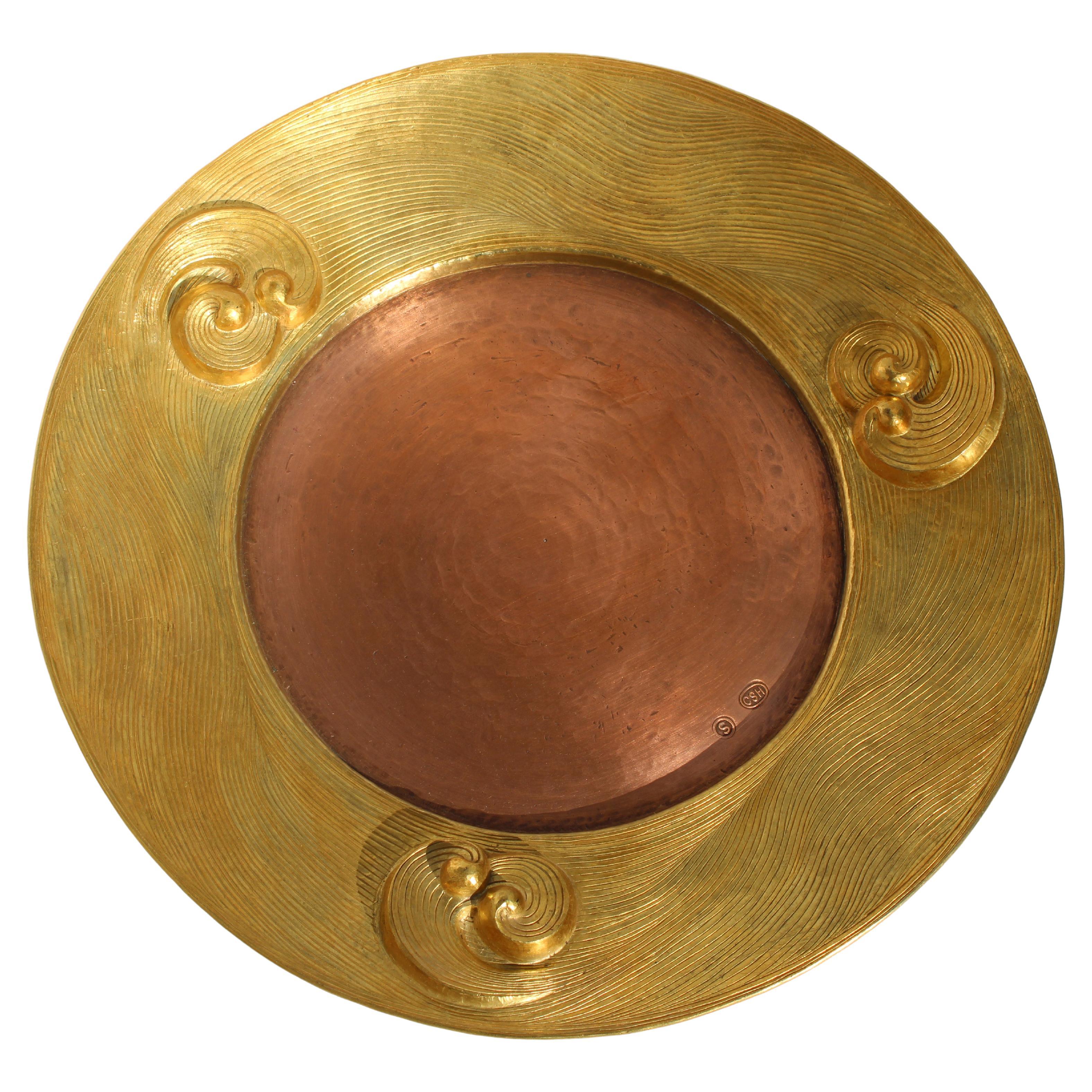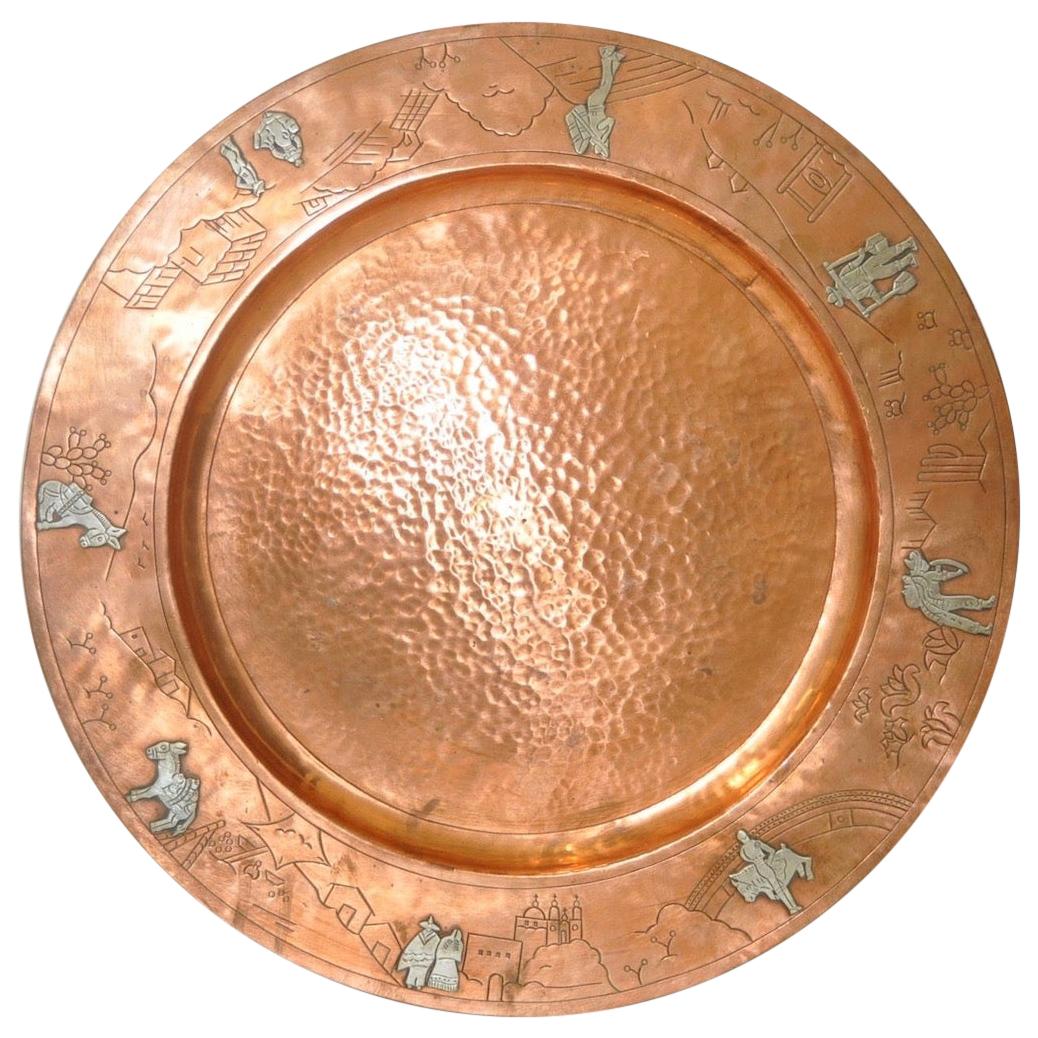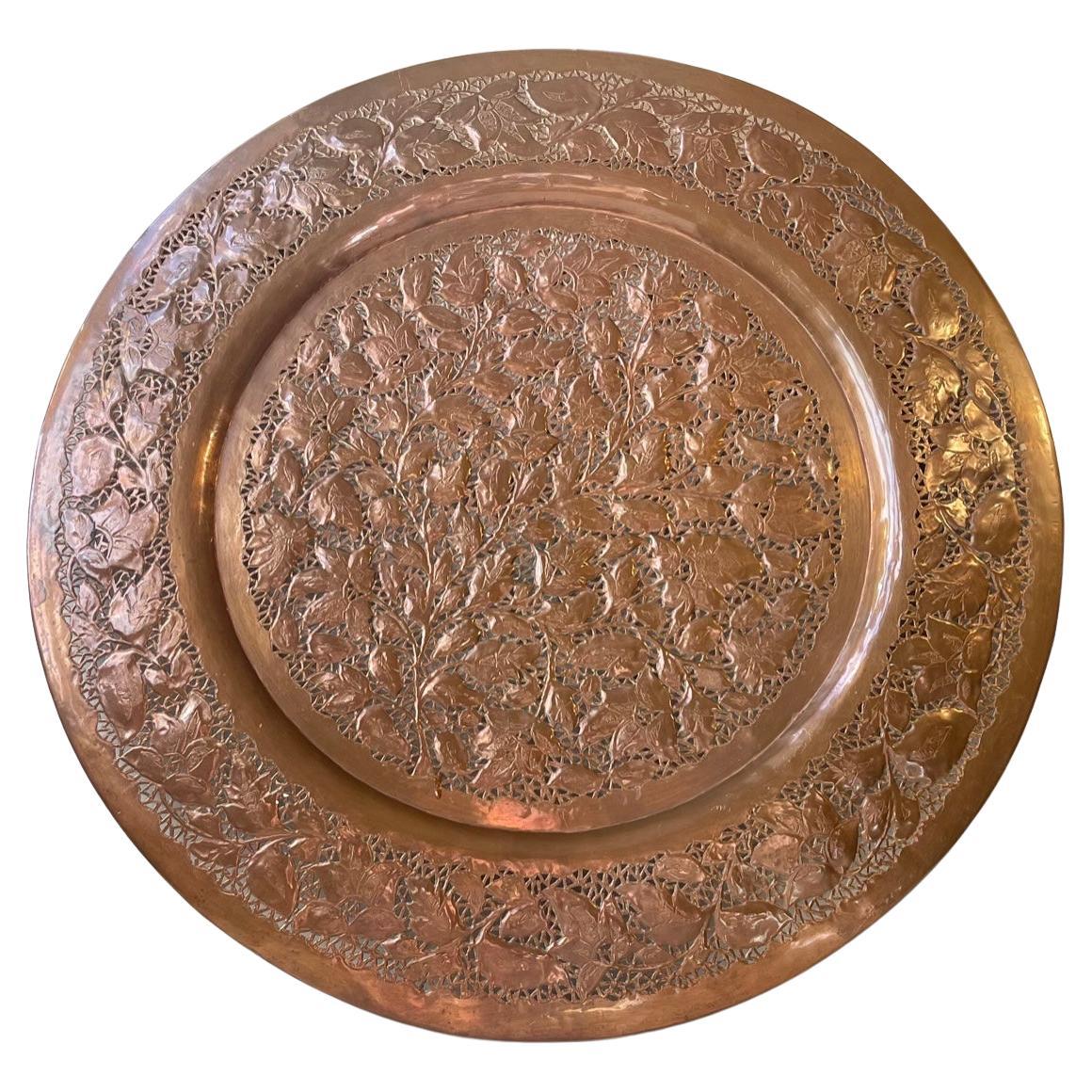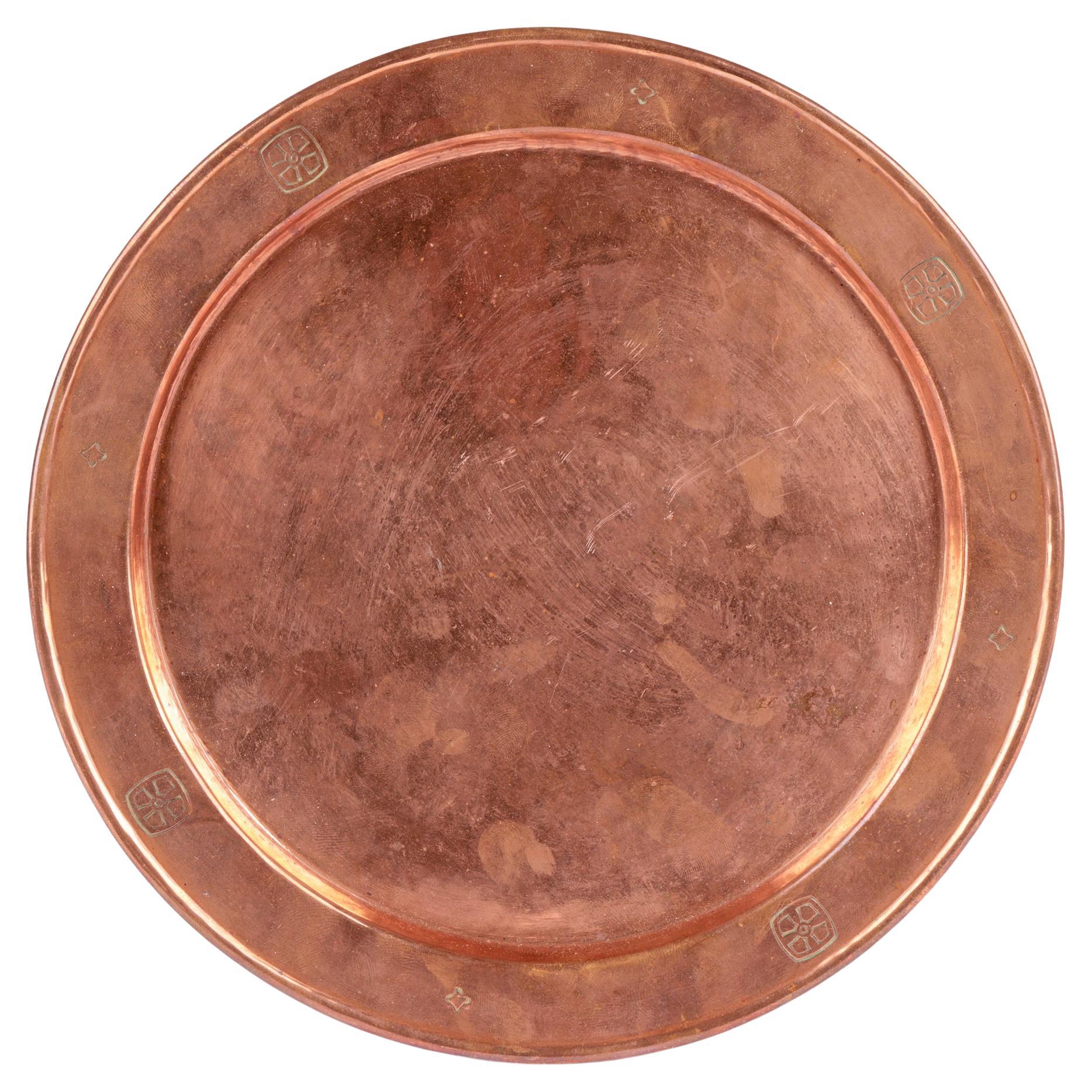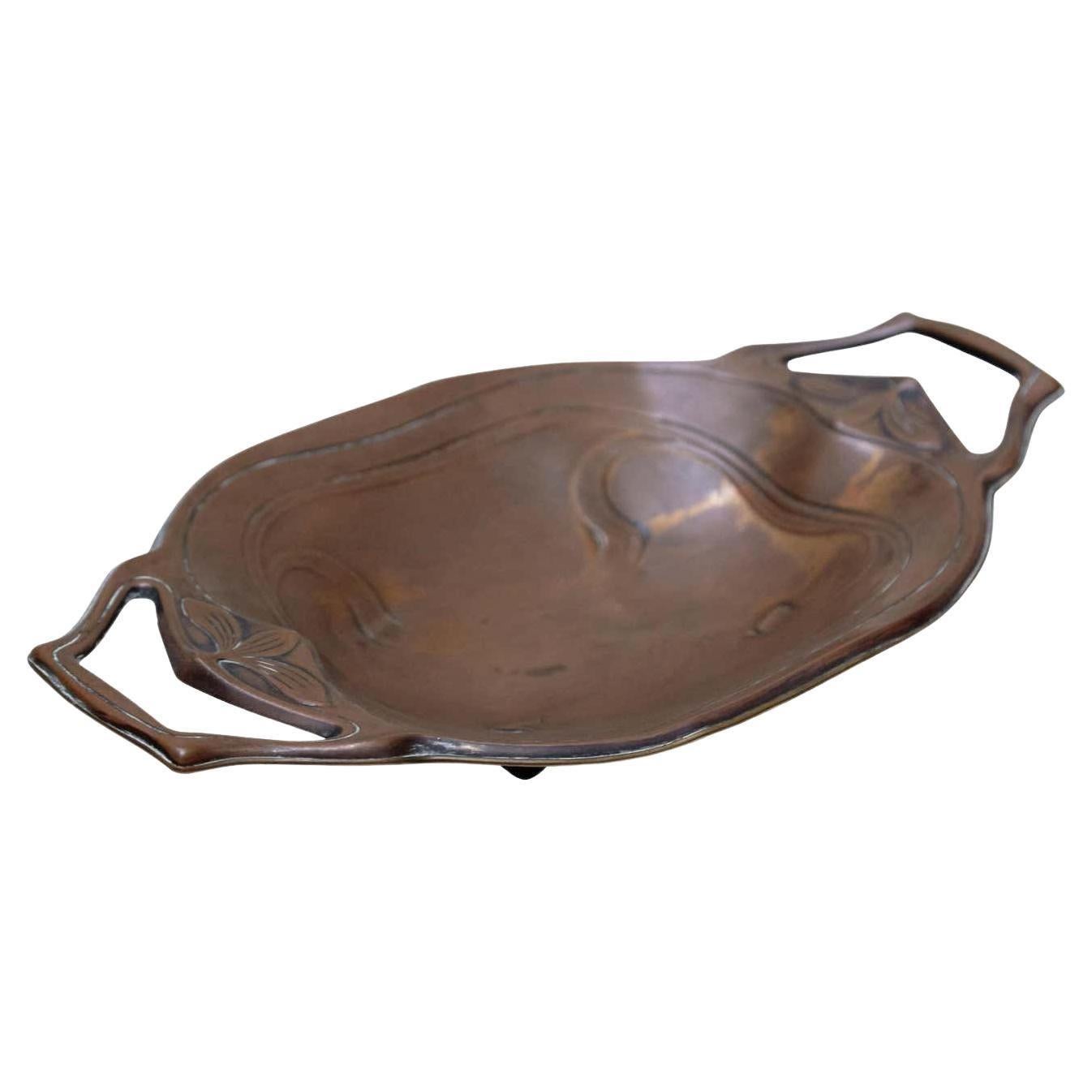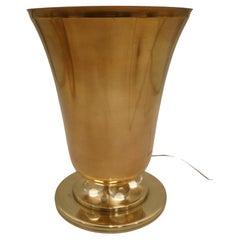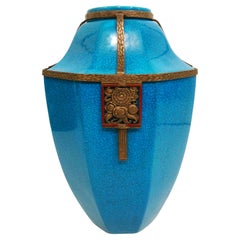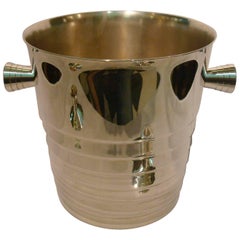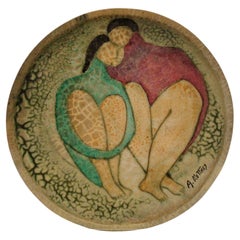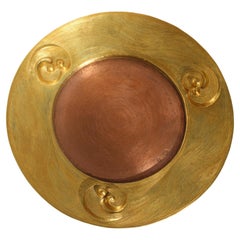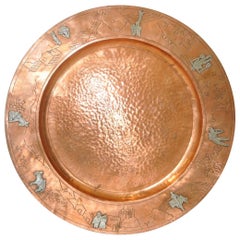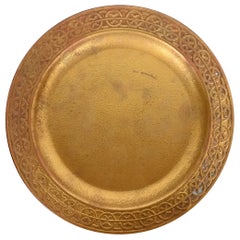Items Similar to Josef Hoffmann - Wiener Werkstatte - Art Deco Copper Hand Hammered Plates
Want more images or videos?
Request additional images or videos from the seller
1 of 7
Josef Hoffmann - Wiener Werkstatte - Art Deco Copper Hand Hammered Plates
$799per item
£602.98per item
€690.32per item
CA$1,126.85per item
A$1,237.15per item
CHF 645.42per item
MX$14,971.19per item
NOK 8,089.36per item
SEK 7,622.30per item
DKK 5,153.09per item
Quantity
About the Item
Josef Hoffmann - Wiener Werkstatte - Art Deco Copper Hand Hammered Plates. We have 5 plates that will be sold individualy.
WIENER WERKSTATTE
The Wiener Werkstatte (Vienna Workshop) exerted an enormous influence on artists and designers throughout the first part of the 20th century. In 1897 a group of progressive artists and designers, led by architect Josef Hoffman and painter Koloman Moser, formed the Vienna Secession which became the Wiener Werkstätte Produktiv-Gemeinschaft von Kunsthandwerken, Wien (the Viennese Workshop and Production Cooperative of Art Works in Vienna) in 1903 when they received backing from a prominent businessman. This enabled them to equip workshops especially for working on modern design in a range of applied arts like glass, metalwork and jewellery.Online art courses
The aim of the Wiener Werkstatte artists and designers was to bring good design and art into every part of people's lives. They also wanted to break with the past and bring new style to everything they produced. Emphasis was placed on the beautiful and unique as well as faultless craftsmanship.
The concept was modeled after Charles Robert Ashbee's Guild of Handicraft. By 1905 it had over a hundred craftsmen, of whom 37 were masters of their trade, its strong point being handmade metalware whose reductive style proved its dependence on hand production.
In addition to the workshops on its own premises, the Wiener Werkstätte had recourse to free-lance craftsmen, students at Kunstgewerbeschule of Vienna (the School of Applied Arts, where both Hoffmann and Moser taught) and contemporary industry. Furniture production, for example, though at one point part of the Werkstätte's program, was more congenially licensed to outside manufacturers such as Gebrüder Thonet and J. & J. Kohn. In 1907, the Wiener Werkstätte took over distribution for the Wiener Keramik, a ceramics workshop of kindred spirit headed by Michael Powolny and Berthold Löffler. The Wiener Werkstätte's ability to change with the times perhaps accounts for its longevity, for despite ongoing financial problems, the enterprise survived for nearly thirty years. Berthold Löffler and Carl Otto Czeschka, who both became associated with the Werkstätte around 1905, brought with them a renewed interest in figuration that had direct bearing on the early work of the Expressionist Oskar Kokoschka. During and immediately following World War I, it was Dagobert Peche whose ornamental, almost baroque fancies exerted the most palpable influence.
We have specialized in the sale of Art Deco and Art Nouveau and Vintage styles since 1995. If you have any questions we are at your disposal. Pushing the button that reads 'View All From Seller'. And you can see more objects to the style for sale. Why are there so many antiques in Argentina?
In the 1880 – 1940 there was a grate wave of immigration encouraged by the periods of war that were taking place. 1st World War took place between 1914 and 1918 2nd World War took place between 1939 and 1945 The immigrants options were New York or Buenos Aires. Tickets were cheap and in Buenos Aires they were welcomed with open arms, as it was a country where everything was still to be done. Argentina was the country of new opportunities, labour was needed and religious freedom was assured, in many cases the of the family travel first until they were settled and then the rest of the family members join them. In the immigrant museum “Ellis Island Immigrant Building” in New York you can se the promotional posters of the boats that would take them to a new life. Between the years 1895 and 1896, Argentina had the highest DGP (gross domestic product) per capita in the world according to the Maddison Historical Statistics index, this situation arose due to the large amount of food being exported to European countries, which were at war. The Argentinean ships left the port of Buenos Aires with food, but they returned with furniture, clothes and construction elements, (it´s common to see this the old buildings of the historic neighbourhood of San Telmo, the beams with the inscription “Made in England)”, as well as many markets that were built in Buenos Aires, such us the San Telmo Market, whose structure was brought by ship and afterwards assembled in 900 Defensa Street. With the great influence of European immigrants living in the country, the children of the upper classes travelled to study in France, resulting in the inauguration of “La Maison Argentinienne”, on 27th of June 1928, in the international city of Paris, which hosted many Argentinians that were studying in Frace. It´s the fourth house to be built after France, Canada and Belgium, being the first Spanish-speaking one. Still in place today (17 Bd Jourdan, 75014, Paris, France). Many of the children of these wealthy families who attended international art exhibitions, museums and art courses abroad, took a keen interest in the European style. This is why Buenos Aires was at the time referred as “The Paris of South America”. Between the years 1890 and 1920 more than a hundred Palaces were built on Alvear Avenue the most exclusive avenue in Buenos Aires. Today some of these palaces have been transformed into museums, hotels and embassies. In the year 1936, the Kavanagh building was inaugurated, it was the tallest reinforced concrete building in South America. During 1994 the American Society of Civil Engineers distinguished it as an “international engineering milestone”, and it´s now considered a World Heritage of Modern Architecture. At the time was common to hire foreign architects such as Le Corbusier, who visited Buenos Aires/Argentina in 1929 and in 1948 he drew up the blueprints for a house built in La Plata City (which was declared a World Heritage Site). In 1947, the Hungarian architect Marcelo Breuer designed “Parador Ariston” in the seaside city of Mar del Plata. After an Argentinean student at Harvard University convinced him to come to Argentina. He worked on an urban development project in the Casa Amarilla, area of La Boca. The Ukrainian architect, Vladimiro Acosta, arrives in Argentina in 1928 and worked as an architect until que moved to Brazil. Antonio Bonet, a Spanish architect who worked with Le Corbusier in Paris, arrives in Argentina in 1937, where he carried out several architectural works and in 1938 designs the well-known BFK chair. Andres Kálnay, of Hungarian origin, made around 120 architectural masterpieces, among which the former Munich brewery stands out, he even made the furniture’s design. The German architect, Walter Gropius, director of the Bauhaus, lived in Argentina, where he wrote articles for “Sur” magazine and founded in Buenos Aires, an architectural firm with Franz Möller, who was also an architect, where he built two houses. At the same time several famous designers decided to immigrate to Argentina, among them we can find the well-known French designer, Jean-Michel Frank, who arrived in the country in 1940 and also worked for the Rockefeller family. Special pieces were made, which were sold exclusively in the country, such as the well-known German company “WMF”, who sold their products by catalogue, which were chosen by the ladies of high society in the list of wedding gifts, as well as the pieces designed by Christofle. The Swiss sculptor Alberto Giacometti, made special pieces for Argentinean mansions. In 1904 the first Jansen branch outside Paris was established in Buenos Aires, as the Argentinean clientele demanded a large amount of furniture, from the end of the 19th century to the mid-20th century. In 1970, the brand Rigolleau Argentina made pieces authorised by Lalique. The brands Maple and Thompson also set up shop in the country. The French plastic artist, Marcel Duchamp moved to Argentina in 1918-1919. Glass signed Gallé, Charder, Leverre, Schneider, Muller and other French firms. They were bought in flower shops and were given to ladies with beautiful floral arrangements. Some furniture manufacturers travelled to international fairs and bough the patterns to produce the furniture in Argentina, such as the furniture firm Englander and Bonta, who bought the patterns in Italy. It is worth mentioning that in Argentina we have the largest community of Italians outside of Italy, as it is estimated that 70 percent of the inhabitants have at least one Italian descendant, followed by Spanish immigrants. The most Important furniture stores in Argentina: Comte is founded in 1934 (under the direct management of Jean Michel Frank in 1940). Nordiska (Swedish company established in 1934). Churba in 1960, a company that brought foreign designers to present their furniture in the country: Denmark: (Arne Jacobsen, Finn Juhl, Bender Madsen, Ejner Larsen, Poul Kjaerholm, Hans Wegner) Sweden: (Hans Agne Jakobsson, Gustavsberg) United States: (Herman Miller) Finland: (Lisa Johansson, Folke Arstrom, Tapio Wirkkala, Alvar Aalto, Timo Sarpaneva) Swedish Factory: (Orrefors) Italy: (Littala, Vico Magistretti, Emma Gismondi, Gae Aulenti, Angelo Mangiarotti, Elio Martinelli, Gianna Celada, Angelo Mangiarotti, Mario Bellini, Carlo Scarpa) Finland: (Olivia Toikka) Plata Lappas (Lappas Silver): a goldsmith shop founded in 1887 in Argentina by Alcibiades Lappas of Greek origin. In 2019, in Argentina took place “the Art Deco world congress” . Argentina currently has more than 100 Art Deco buildings and another 90 Art Nouveau buildings throughout the city of Buenos Aires. Argentina is a country that has not been involved in many wars, which is why it has been a refuge for works of art and antiques from different periods of time, unlike European countries. That is way many collectors, museums and antique dealers from all over the world visit it, you should not miss the opportunity to visit this great country.
- Attributed to:Josef Hoffmann (Artist)
- Dimensions:Height: 0.4 in (1 cm)Diameter: 11.82 in (30 cm)
- Style:Vienna Secession (Of the Period)
- Materials and Techniques:
- Place of Origin:
- Period:
- Date of Manufacture:1900´s
- Condition:Wear consistent with age and use.
- Seller Location:Buenos Aires, AR
- Reference Number:1stDibs: LU2027342196972
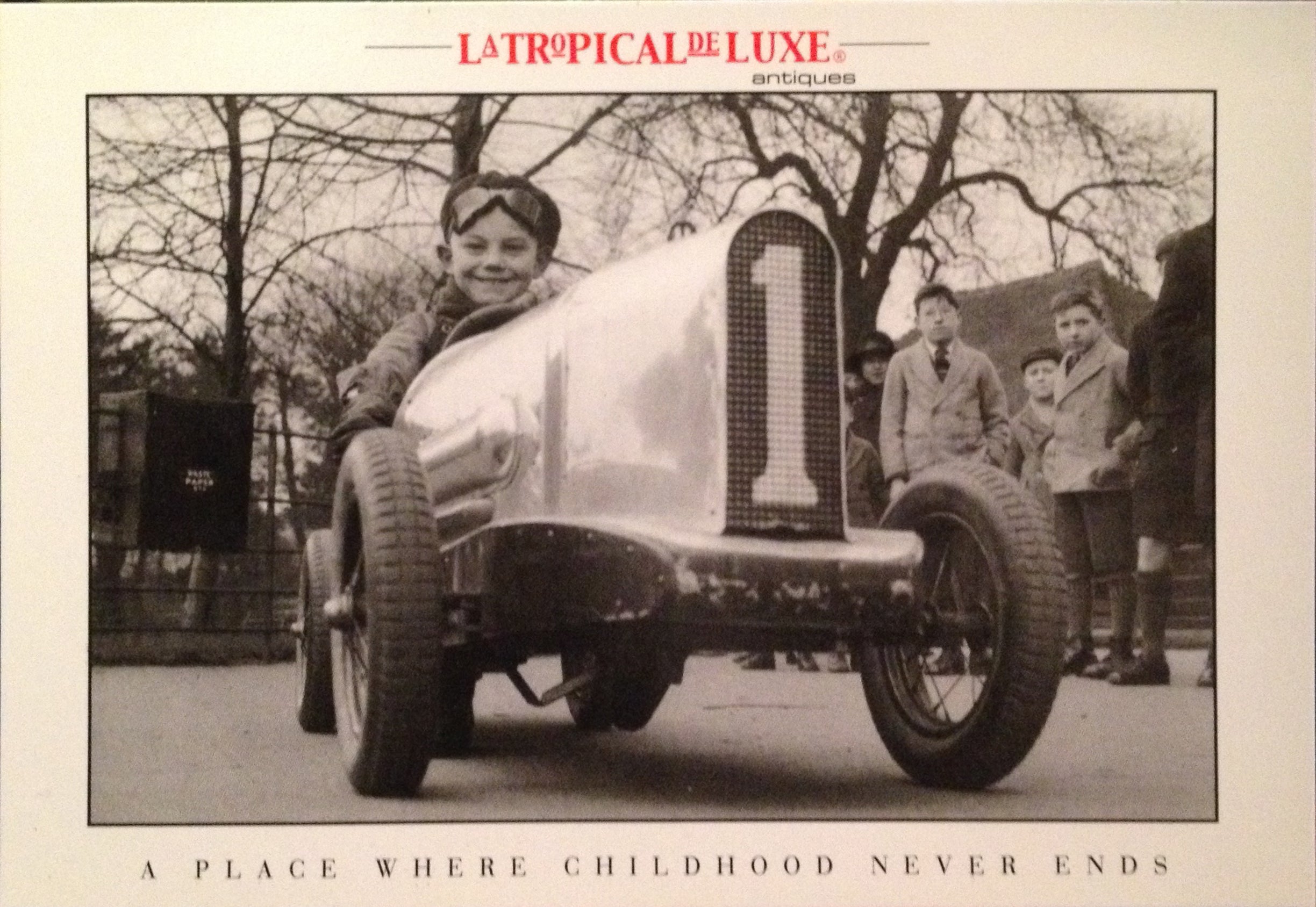
About the Seller
4.9
Vetted Professional Seller
Every seller passes strict standards for authenticity and reliability
Established in 2002
1stDibs seller since 2016
323 sales on 1stDibs
Typical response time: <1 hour
- ShippingRetrieving quote...Shipping from: Buenos Aires, Argentina
- Return Policy
Authenticity Guarantee
In the unlikely event there’s an issue with an item’s authenticity, contact us within 1 year for a full refund. DetailsMoney-Back Guarantee
If your item is not as described, is damaged in transit, or does not arrive, contact us within 7 days for a full refund. Details24-Hour Cancellation
You have a 24-hour grace period in which to reconsider your purchase, with no questions asked.Vetted Professional Sellers
Our world-class sellers must adhere to strict standards for service and quality, maintaining the integrity of our listings.Price-Match Guarantee
If you find that a seller listed the same item for a lower price elsewhere, we’ll match it.Trusted Global Delivery
Our best-in-class carrier network provides specialized shipping options worldwide, including custom delivery.More From This Seller
View AllArt Deco Uplight Brass Metal Table Lamp, French, 1930s
Located in Buenos Aires, Olivos
A lovely example of Art Deco that shows great style and imagination is this French table lamp trumpet shape. Cream coloured on the inside and takes a normal bulb, you can use energy ...
Category
Mid-20th Century French Art Deco Table Lamps
Materials
Brass
Art Deco Boch La Louviere Brass Mounted Glazed Vase. Belgium 1920´s
By Boch La Louviere
Located in Buenos Aires, Olivos
Art Deco Boch La Louviere Brass Mounted Glazed Vase. Belgium 1920´s.
Very Rare blue Glazed ceramic vase. The vase has a hexagonal shape and is adorned with bronze or brass decorati...
Category
Vintage 1920s Belgian Art Deco Vases
Materials
Brass
$2,499 Sale Price
28% Off
Free Shipping
Christofle Art Deco Design Champagne, Wine Cooler, France, 1980s
By Christofle
Located in Buenos Aires, Olivos
Christofle Art Deco design champagne, wine cooler, France, 1980s. Very chic!
The candleholders on the pictures are not included, will be sold separate.
We have specialized in the sa...
Category
Vintage 1980s French Art Deco Wine Coolers
Materials
Metal
Art Deco Andre Metthey Glazed Ceramic Plate / Charger. France 1910-20
By André Metthey
Located in Buenos Aires, Olivos
Fantastic Art Deco Wall Glazed Ceramic Plate. A couple in Love. Very Romantic, both legs together form a heart. Spectacula piece of a fantastic Artist.
André Metthey...
Category
Early 20th Century French Art Deco Ceramics
Materials
Ceramic
Art Deco / Modernist Style. Hermès Ice Bucket / Bottle Cooler.
By Hermès
Located in Buenos Aires, Olivos
Art Deco / Modernist Style. Hermès Ice Bucket / Bottle Cooler.
Hermès Ice Bucket / Cooler, Art Deco / Modernist Style. Marked on bottom.
Fine Quali...
Category
Mid-20th Century French Art Deco Barware
Materials
Brass
Hermès - Pair of Skycraper Design Candle Holders, France c1920´s
By Hermès
Located in Buenos Aires, Olivos
Hermès - Pair of Skycraper Design Candle Holders, France c1920´s
These are striking candelabras with a distinctly architectural design. Its clean lines and geometric form evoke a s...
Category
Early 20th Century French Art Deco Candelabras
Materials
Brass
You May Also Like
Copper Repousse Plate 13” Dia Handcrafted in India By Stephanie Odegard
By Stephanie Odegard Collection
Located in New York, NY
Available Sizes:
13” Dia
22" Dia
31” Dia
Round repousse copper lotus form plates. Inspired by the ancient Tibetan cloud motif. Hand hammered, hand chiseled copper...
Category
Late 20th Century Nepalese Arts and Crafts Decorative Dishes and Vide-Poche
Materials
Copper
Mid-Century Modern Mexican Copper Platter with Sterling Figures, circa 1950s
Located in San Francisco, CA
Midcentury copper platter with sterling, circa 1950s
Fantastic copper platter surrounded with sterling donkey, bull fighter, farm worker, and variou...
Category
Mid-20th Century Mexican Mid-Century Modern Serving Pieces
Materials
Sterling Silver, Copper
Vintage Large Middle Eastern Tray in Piercet Copper, 1960s
Located in Esbjerg, DK
Extra-large (57 cm) Persian copper tray decorated with leaves and flowers with intricate perforations. It was made in Pakistan or India during the 1960s or earlier. It can be used as...
Category
Vintage 1960s Asian Mid-Century Modern Serving Pieces
Materials
Copper
$553 Sale Price
20% Off
Tiffany Studios New York Bronze Doré Plate
By Tiffany Studios
Located in South Bend, IN
A gorgeous Arts & Crafts or Art Deco period gilt bronze plate
By Tiffany Studios
New York, USA, Early 20th Century
Measures: 7.5"W x 7.5"D x 0.5"H.
Good original vintage condition.
Category
Early 20th Century American Art Deco Platters and Serveware
Materials
Bronze
Birmingham Guild Arts & Crafts Copper Paten or Tray
Located in Bishop's Stortford, Hertfordshire
A stylish and heavily hand-crafted Birmingham Guild Arts & Crafts copper paten or tray dating from around 1915. The tray of flat circular shape has a raised...
Category
Vintage 1910s English Arts and Crafts Serving Pieces
Materials
Copper
Catalan Modernist Copper Tray from Barcelona, circa 1920
Located in Barcelona, ES
Catalan modernist copper tray. Manufactured in Barcelona, circa 1920. In original condition with minor wear consistent of age and use, preserving a beautiful patina.
Category
Vintage 1920s Spanish Art Deco Serving Pieces
Materials
Copper
$469 Sale Price
35% Off
More Ways To Browse
Hammered Brass Plate
Josef Hoffmann Glasses
Josef Hoffmann Wiener Werkstatte Silver
Berthold Loffler
Gorham Old French
International Sterling Courtship
International Sterling Valencia
Japanese Cutlery
Japanese Modern Flatware
Landers Frary And Clark
Landers Frary
Marble Trivet
Menage Modern Vintage
Nissen Pepper
Oneida Community Plate
Porcelain Napkin Rings
Reed And Barton 18th Century Flatware
Reed Barton Tara
